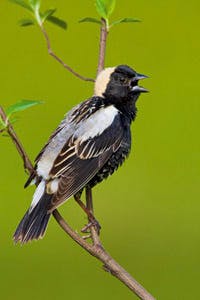Its name may sound silly, but the bobolink is a serious songster—and a world-class traveler. These dark birds sail the night skies, migrating to grasslands, hayfields and meadows in North and South America—a round trip that’s about 12,500 miles long.
For generations, their jubilant songs have stirred mixed reactions. Poets such as Emily Dickenson and William Cullen Bryant drew inspiration from the songbird’s crooning call. But farmers know bobolinks as “rice-birds” for the damage a hungry flock can inflict on crops.
The bobolink reached its heyday back when people still drove horse-powered buggies, expanding its range westward as forests fell to make room for more pastures and hayfields. But today, the bobolink’s population is shrinking.
Stay Informed
Learn more about grasslands.
Researchers point to pesticides, climate change and farming practices as the main culprits behind the bobolink’s decline. In the United States, high-tech farming equipment and shorter growing seasons spell trouble for fledgling chicks that are trapped in their grassland nests when fields are harvested and mowed—while farmers overseas fire shotguns and cannons to scare bobolinks away.
But all is not lost for these blackbirds yet. Farmers are starting to realize that bobolinks can be good guests, since they also feed on crop-eating pests.
So perhaps one day soon, both the farmers and poets will hear music in the bobolink’s tune.
